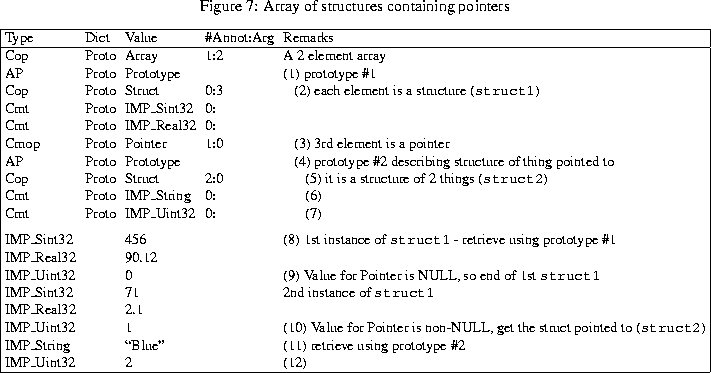 |
As a third example, let us consider how the concept of pointers can be
realized by type specifications. For this, we use a meta operator
(typically, we would use the operator MP_CopProtoPointer provided
in the prototype dictionary4) which has 0 in its number-of-argument
field and a prototype annotation attached to the meta operator
specifying the type of the data ``pointed to''. The corresponding IMP_Uint32 which is transmitted at data communication
and which precedes the data ``pointed to'', may then have the value
zero (pointer is NULL) or one (pointer is not NULL).
Consider an array of two struct1 structures as defined below:
struct struct2 {
MP_String a;
MP_Uint32 b;
}
struct struct1 {
MP_Sint32 x;
MP_Real32 y;
struct struct2 * struct2ptr; // a ptr to struct2
}
{
{456, 90.12, NULL }, - First structure
{71 , 2.1, &{"Blue", 2}} - Second structure }
& sign indicates a
``pointer to'' that structure.
Figure 7 shows what this would look like in MP.
The first prototype on line 1 indicates that each element of the
array is a 3-field structure. Line 3 indicates that the third field
is a pointer to an object.
Lines 4 - 7 give the prototype describing the object pointed
to on line 3. The structuring prototype on line 5 says that the
object pointed to on line 3 is a 2-field structure. The prototyped
data tree follows the prototype tree beginning on line 8. The third
field of the first element of the array appears on line 9. This is
the field corresponding to the structure pointer from line 3. The
value here is 0, indicating a NULL pointer, so the receiver
skips the nested prototype (lines 4 - 7) describing the structure
pointed to. However, the value for the pointer field for the second
array element on line 10 is 1 (non-NULL), so the receiver
uses the prototype from lines 4 - 7 to read the object pointed to:
Line 6 tells the receiver to read a String (found on line 11), and
line 7 says to read a Uint32 (found on line 12). There were only
two elements to the array, so the end of the MP Tree has been reached.